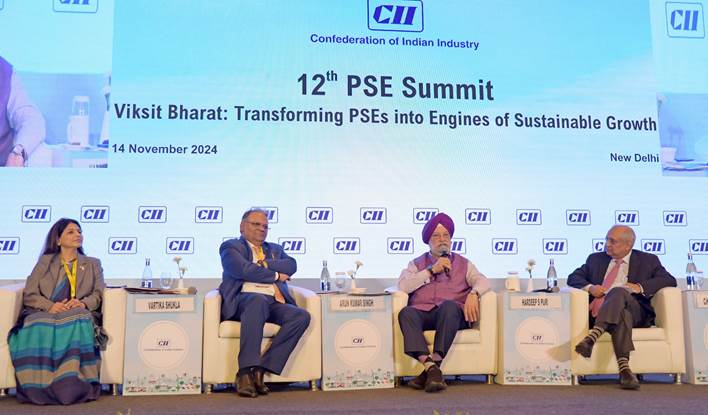CII : Minister Hardeep Singh Puri Highlights India’s Economic Growth and Vision for Sustainable Energy at the 12th Public Sector Enterprises Summit
- Minister outlines vision for India’s energy sector, emphasizing 3 key principles: availability, affordability, and sustainability
“India is poised to become the third-largest economy in the world within the next five years and a developed nation by 2047,” stated Shri Hardeep Singh Puri, Minister of Petroleum and Natural Gas, in his address at the 12th Public Sector Enterprises (PSE) Summit, organised by Confederation of Indian Industry (CII) here today. Reflecting on India’s transformation from a fragile economy in 2014 to the world’s fifth-largest economy today, Shri Puri highlighted the role of Public Sector Enterprises (PSEs) in driving the nation’s remarkable economic growth and advancing its sustainable energy future.
Shri Puri underscored that India’s trajectory toward becoming a global economic powerhouse is rooted in robust reforms and the dedication of its PSEs. He praised the resilience and performance of Public Sector Enterprises over the last decade, noting that their contributions have been integral to India’s economic stability and progress. “As we look to the future, the next few years will be critical in laying the groundwork for India’s next leap forward,” he said.
The Minister shared several key statistics illustrating the remarkable performance of India’s Public Sector Enterprises. The net worth of Central Public Sector Enterprises (CPSEs) has increased by 82%, from Rs 9.5 trillion in FY14 to Rs 17.33 trillion in FY23. The contribution of CPSEs to the national exchequer—through excise duties, taxes, and dividends—has more than doubled, rising from Rs 2.20 lakh crore in FY14 to Rs 4.58 lakh crore in FY23.
He also highlighted that the net profit of profit-making CPSEs grew by 87%, from Rs 1.29 lakh crore in FY14 to Rs 2.41 lakh crore in FY23. Furthermore, the total market capitalization of all 81 listed PSEs has grown by 225% under the leadership of the Prime Minister Shri Narendra Modi, outpacing both the PSE index and the BSE Sensex over the past decade.
The Minister outlined a vision for India’s energy sector, emphasizing three key principles: availability, affordability, and sustainability. “Sustainability is the cornerstone of our energy strategy and aligns directly with our larger vision of transforming PSEs into engines of sustainable growth,” he said.
A prime example of India’s focus on sustainability, Shri Puri highlighted the significant progress in bioethanol blending. “From 1.53% in 2014, ethanol blending has surged to 15% in 2024, with the government advancing the target of 20% blending to 2025—five years ahead of schedule,” he said. The Minister also revealed that discussions have already started on developing a roadmap for the post-2025 phase i.e. after attainment of 20% ethanol blending target, ensuring continued growth in the bioethanol sector and advancing India’s renewable energy goals.
On the subject of fossil fuels, the Minister acknowledged that while India is steadily transitioning to cleaner energy sources, fossil fuels will continue to be part of the energy mix for the foreseeable future. He highlighted that the government’s approach would be to balance the energy transition while ensuring energy security, stability, and affordability for all citizens.
Shri Puri also highlighted the major reforms in the Exploration and Production (E&P) sector, which have opened up significant new areas for oil and gas exploration. “We have reduced No-Go areas in Exclusive Economic Zones (EEZ) by 99%, allowing for the largest-ever offering of 1,36,596 square kilometers in a single bid round under the Open Acreage Licensing Policy (OALP). Of these, 13 blocks, covering 51,405 square kilometers, were previously classified as ‘No-Go’ areas,” he explained.
The Minister also emphasized India’s growing potential in green hydrogen, noting that the country’s local demand, production capacity, and consumption patterns make it an ideal candidate to become a global leader in green hydrogen production. He also touched upon the integration of Artificial Intelligence (AI) in India’s energy systems, citing technological innovation as a key driver of efficiency and sustainability.
The Minister congratulated the CII for its efforts in empowering Public Sector Enterprises through organizing summits that provide a platform for collaboration and knowledge exchange. “These summits enable PSEs to share experiences, challenge norms, and find solutions for future challenges,” he said. He emphasized the importance of collective efforts from all stakeholders to build a future where India’s PSEs stand as pillars of excellence, integrity, and progress, guiding the nation towards sustainable growth.
